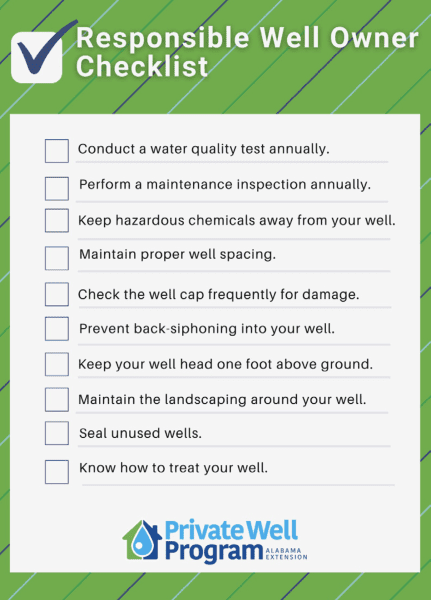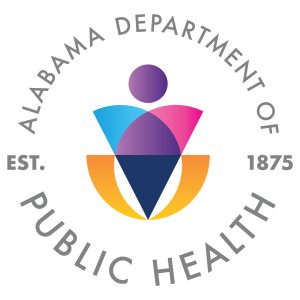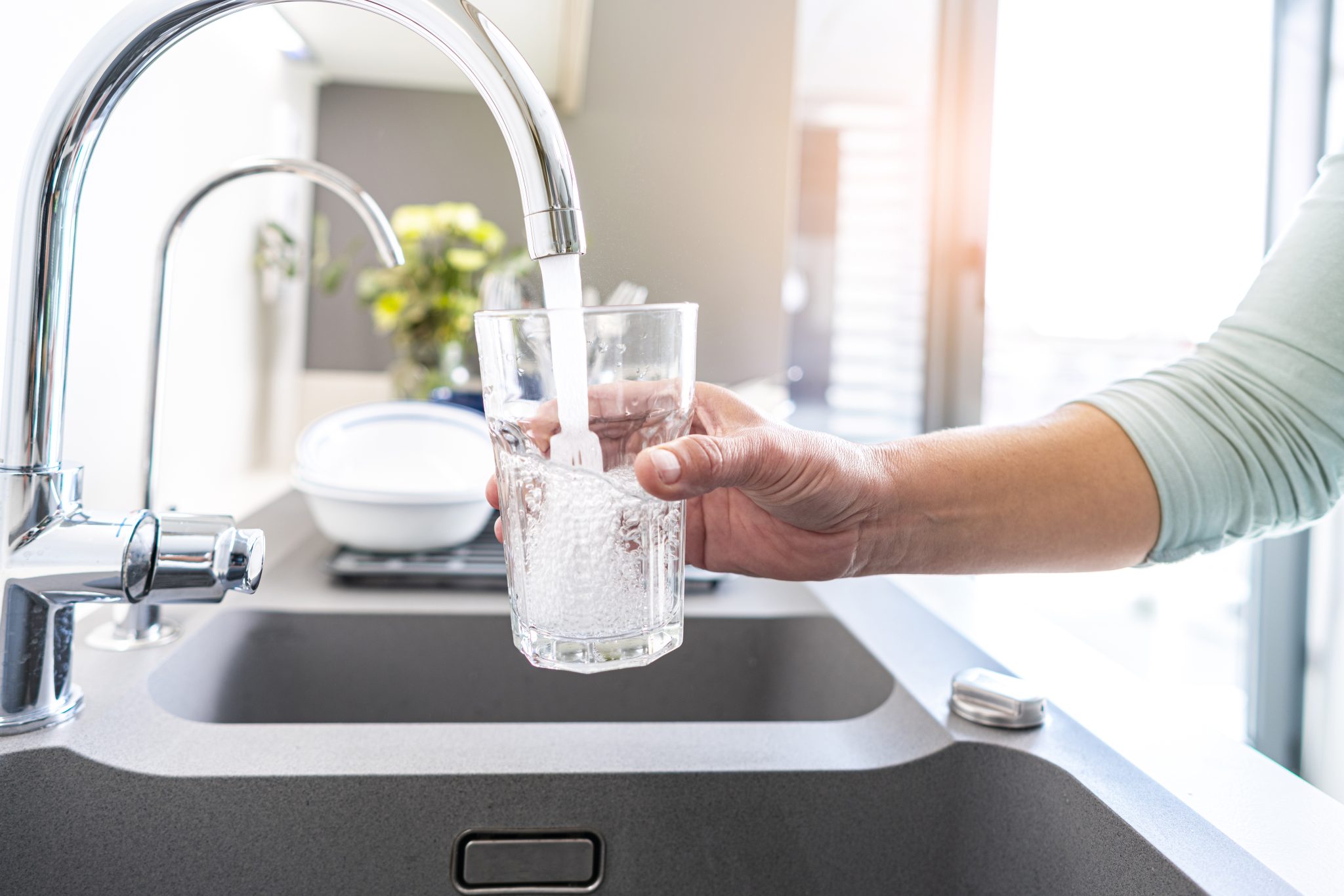Fish & Water

The Alabama Department of Public Health and the Alabama Cooperative Extension System encourage all well owners to have their water tested. They also offer guidance on how to take a sample, interpret test results, and treat contamination.
Importance of Testing Household Well Water
The quality of a water source may change over time but go unnoticed as the water may smell, appear, and taste the same. Because of this, many well owners will not know that their water is contaminated unless they get it tested.
The United States Environmental Protection Agency (EPA) rules that protect public drinking water systems do not apply to individual water systems such as wells. It is a well owner’s responsibility to ensure that the water they are drinking is safe. Regular testing of residential well water will identify any problems, ensure that the water is suitable for its intended use, track water quality over time, and determine the effectiveness of a treatment system if there is one.
The Centers for Disease Control and Prevention (CDC) recommends that well owners check for mechanical issues each spring and perform a water quality test at least once a year. Owners should also test well water quality under any of the following circumstances:
- A baby is expected in the home
- The well has recently been affected by a flood
- A chemical spill has occurred within 500 feet of the well
- A home with a well is being purchased
- Neighbors have recently found contaminants in their groundwater
- The well is old or shallow
- The well does not meet construction codes
- Someone in the household is suffering from gastrointestinal illness
- A nearby development is using hazardous materials
- The household plumbing is showing signs of deterioration
- There is a change in the well water’s taste, appearance, or smell
Step 1: Find When and Where to Get Your Water Tested
A simple way to get your well water tested for bacterial contamination (total coliforms, fecal coliforms) is to contact your county health department. Find the contact information for a health department near you in “Where to Get Your Well Water Tested” on the Alabama Extension website, www.aces.edu. Tests provided by the Alabama Department of Public Health (ADPH) may differ in price depending on the county where you live but are usually very affordable. Water samples are received and tested during regular work hours Monday through Thursday, and it is advised that you return samples the same day you pick up the test kit.
If you would like to perform a more comprehensive test for substances such as nitrate or heavy metals, you may need to contact a certified drinking water lab and ask what testing services are offered to private well owners.
Step 2: Collect a Water Sample
Water samples being tested for bacterial contamination are time sensitive and must be submitted no longer than 24 hours after collecting a sample. Check with the lab providing the test to ensure that it is receiving samples on the day you want to deliver it.
Follow these instructions to collect a water sample for the ADPH:
- Familiarize yourself with the contents of the testing kit. Note: Use only sterilized public health laboratory bottles provided. Do not rinse the bottle before filling it or use any device, such as a cup or funnel, to fill the bottle. Fill it directly from the tap.
- Identify the site from which to collect the sample. Ideally, sample at the tap that is regularly used for drinking and cooking.
- Remove any treatment devices that are on the tap to eliminate chances of false-positive tests, as these devices can often house bacteria.
- Sanitize the tap by rubbing the inside with a swab of rubbing alcohol or by running a small lighter flame along the surface and inside the tap nozzle.
- Flush the nozzle for at least 3 minutes to remove any stagnant water from the pipes.
- Unscrew the sample bottle cap, and fill the bottle to the designated 100 milliliter (ml) mark, being careful not to touch the interior of the sampling bottle and introduce contaminants. Fill the sample bottle to at least the 100 ml mark but not over so there is air space for mixing the sample.
- Screw the cap back on the bottle tightly to avoid spills or leaks.
- Complete the sampling sheet provided by the ADPH. 9. Return the water sample to the county health department office.
Step 3: Interpret Test Results
The ADPH test results include a result key on the bottom right corner of the sample results form. Acronyms for the results are as follows:
CA – coliform absent
CP – coliform present
FA – fecal coliform absent
FP – fecal coliform present
ECA – E. coli absent
ECP – E. coli present
C/T – confluent growth or too numerous to count UNS – unsatisfactory
If results show the presence of coliform (CP), fecal coliform (FP), or E. coli (ECP), the sample tested is positive for these bacteria per 100 ml of water; therefore, follow-up action is required.
If the form indicates confluent or too numerous to count (C/T), a high number of bacteria are present. These bacteria may mask underlying coliform bacteria, and the sample should be recollected and tested again.
Unsatisfactory results (UNS) require further clarification from the lab. Reasons the results may be deemed UNS are as follows:
- Sample was more than 30 hours old (sample must be tested within 6 hours of collection for an accurate fecal/E. coli test)
- Sample leaked in transit
- Sample was received on a nonscheduled testing day
- Form was incomplete or inaccurate
- Sample was submitted in an unapproved bottle
- Sample was submitted with less than 100 ml of water
- Sample bottle was submitted with more than 100 ml of water
- Laboratory accident
- Other
If your sample sheet reads UNS, call the lab that performed the test for an explanation.
For more information about coliform bacteria, see Extension publication, “Coliform Bacteria in Well Water” available at www.aces.edu.
Step 4: Treat Contamination

Responsible Well Owner Checklist:
– Conduct a water test annually.
-Perform a maintenance inspection annually.
-Keep hazardous chemicals away from your well.
-Maintain proper well spacing.
-Check the well cap frequently for damage.
-Prevent back-siphoning into your well.
-Keep your well head one foot above ground.
– Maintain the landscaping around your well.
-Seal unused wells.
-Know how to treat your well.
If test results show bacterial contamination, determine the source of contamination and remediate it as soon as possible to eliminate the risk of continued contamination. An immediate remedy for bacterial contamination of a well is disinfecting or shock- chlorinating the well with chlorine bleach. Shock chlorination is a temporary measure, and bacteria will likely return if the source of the contamination is not addressed. Other methods include using ultraviolet light, introducing ozone, and boiling.
Shock Chlorination
Shock chlorination using chlorine bleach is an immediate but temporary remedy for bacterial contamination. This method introduces a high concentration of chlorine to the water for at least 12 to 24 hours. The bleach solution is mixed based on the volume of water present in the water system, so the depth, diameter, and water level of the well must be known.
Concentrated chlorine solutions can be dangerous; therefore, personal protective equipment (gloves, goggles, and a protective apron) must be worn. To reduce the risk of exposure to hazardous chemicals as well as to protect the well components, have a licensed well driller or pump installer disinfect the well. A list of licensed well drillers can be found on the Alabama Department of Environmental Management (ADEM) website.
Well owners who decide to shock chlorinate their well themselves can refer to the Water Systems Council (WSC) information sheets or instructions in Alabama Extension publication, “Flooded Wells: Shock Chlorination.”
Continuous Chlorination
A continuous chlorination system is attached after the well head pump to inject a chlorine solution or dry powder into the water ahead of the storage tank. The effectiveness of chlorination depends on a number of factors, one being contact time or the amount of time water is in contact with chlorine. Another factor is water quality. Untreated water can affect chlorination, as some contaminants (such as iron, manganese, hydrogen sulfide, ammonia, and organic materials) can affect the chlorine and make it unavailable for the targeted contaminants. This can be addressed, however, by pretreating the water. Other factors that can affect chlorination are water temperature and pH.
Ultraviolet Light
Ultraviolet (UV) light is another effective treatment for bacterial contamination in well water systems. Unlike chlorination, UV radiation treatment can be fast without adding anything to the water or causing additional taste or odor. In this method, water is exposed through UV radiation as it flows over a glass sleeve encasing a UV light bulb. The pathogens must be exposed to UV light in order to be eliminated, and sometimes suspended particles in the untreated water can interfere with the treatment. UV treatment is, therefore, often paired with a filtration method and should be the last treatment used in a sequence. Water having high amounts of calcium and magnesium may also coat the glass sleeve with a scale, so the unit should be routinely cleaned according to manufacturer instructions.
Ozone
Ozone is a highly reactive gas commonly used in water treatment to kill bacteria and some viruses. Because this treatment method is relatively expensive, it is most useful where multiple water quality problems must be addressed.
Boiling
Boiling water for about 1 minute kills most bacteria. This method can be used during emergencies and can only treat small amounts of water at a time. It is not a long- term or continuous option for water supply disinfection.

 Jessica Curl, Extension Outreach Programs, Crop, Soil, and Environmental Sciences, Coordinator of the Alabama Private Well Program, Auburn University.
Jessica Curl, Extension Outreach Programs, Crop, Soil, and Environmental Sciences, Coordinator of the Alabama Private Well Program, Auburn University.
New May 2022, Step-by-Step Guide to Getting Your Well Water Tested, ANR-2867

